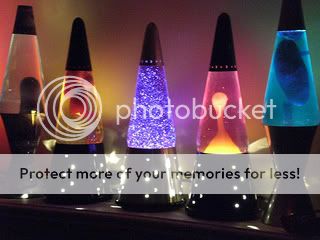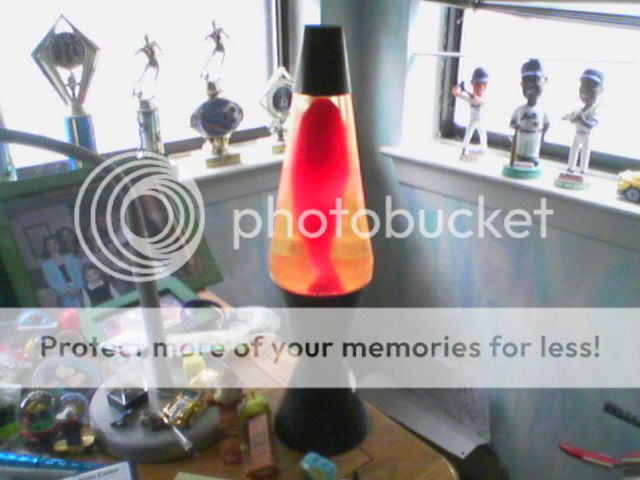CreARTive Sunday 05/11/08: Lava Lamps
 A lava lamp is a novelty item typically used for decoration and ambience rather than illumination; the slow rise and fall of the randomly-shaped blobs of wax is fancifully suggestive of the flow of lava, hence the name. The moving blobs of wax are constantly showing an art show !
A lava lamp is a novelty item typically used for decoration and ambience rather than illumination; the slow rise and fall of the randomly-shaped blobs of wax is fancifully suggestive of the flow of lava, hence the name. The moving blobs of wax are constantly showing an art show !
The lamps are available with a wide variety of container styles and colors of wax and liquid. They rose to prominence in the late 1960s and early 1970s and are often associated with the hippie movement of that period.
The lamp consists of an incandescent bulb which heats the contents of a tapered glass bottle containing water and a translucent mix of wax and carbon tetrachloride (although other combinations may be used). A metallic wire coil which is hidden in the base of the lamp both furthers the necessary heat convection and suspends the falling blobs of liquid wax.
The wax is slightly denser than the water at room temperature, and slightly less dense than the water under marginally warmer conditions. This occurs because the wax expands more than the water when both are heated.
While common wax is much less dense than water and would float in it at any room temperature, a heavy, nonflammable solvent is added to tune the wax density to be just slightly higher than that of water.
Wax at the bottom heats until it melts, eventually becoming less dense than the liquid around it; portions of wax thus overcome their surface tension and rise. Near the top, away from the heat source, the wax cools and contracts, and as its density thus increases it begins to fall.
An Englishman, Edward Craven Walker, invented the original and best-known lava lamp in the 1960s. His U.S. Patent 3,570,156 for “Display Device” was filed in 1965 and issued in 1968. Walker’s company was named Crestworth and was based in Poole in the United Kingdom.

Walker named the lamp Astro and had various variations such as the Astro Mini, the Astro Coach lantern and presented it at a Brussels trade show in 1965, where the entrepreneur Adolph Wertheimer noticed it. Wertheimer and his business partner Hy Spector bought the American rights to the product and began to produce it as the “Lava Lite” via a corporation called Lava Simplex International, which is the origination of the use of the term “lava” in conjunction with this sort of lamp. Wertheimer dropped out of the development of the product, while Spector went on to manufacture and market the “Lava Lite” in his Chicago factory in the mid-60’s. The lamps were a huge success nationwide throughout the rest of the ’60s and early ’70s.

This is our favorite lava lamp (please excuse the mess !). We keep it in my son’s room. We got it for 10 bucks at a neighborhood tag sale. We’ve had it for about a couple of years now. It’s so cool the way the wax moves around from the heat of the light bulb and coils.
Click here to return toSans Souci who is hosting CreARTive Sunday !!!
|
instrumentalpavilion wrote on May 10, ’08
: )
|
|
sanssouciblogs wrote on May 10, ’08
I love it, groovy! I never knew or thought about what the blob was. It’s a great collector’s item.
|
|
lauritasita wrote on May 10, ’08
You know, I didn’t even know what the heck this was until I saw it at the tag sale !
|
|
starfishred wrote on May 11, ’08
really cool they are all the rage over here-
|
|
lauritasita wrote on May 11, ’08
Heidi, are they still as popular ? Wow, I want to look for some more !
|

Comments
CreARTive Sunday 05/11/08: Lava Lamps — No Comments
HTML tags allowed in your comment: <a href="" title=""> <abbr title=""> <acronym title=""> <b> <blockquote cite=""> <cite> <code> <del datetime=""> <em> <i> <q cite=""> <s> <strike> <strong>